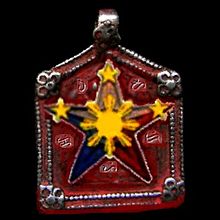- Pulahan
-
Pulahan 
An agimat, intended to be worn with a necklaceTotal population Currently none;
10,000–15,000 (c.1900)Founder Babaylan Regions with significant populations  (Visayas)
(Visayas)Religions Folk Catholicism Scriptures Bible, texts relating to Philippine mythology Languages Visayan languages, Spanish, Tagalog The Pulahan (literally "those wearing red"; pl: Pulahanes; Spanish: Pulajan), also known as Dios-Dios, refers to the members of a religious revival of Philippine beliefs that developed in the Visayas prior to the Philippine Revolution. At its peak, it numbered around 10,000–15,000 adherents. The movement was severely crippled during the Philippine Revolution after the Philippine Constabulary took over patrols in Samar, when the U.S. military declared the island as "pacified".
Contents
Beliefs
Pulahanes practiced a syncretic religious revival centered mostly on Philippine mythology and Folk Catholicism. Individual beliefs include the use of anting-antings as well as the revival of the babaylan.[1] Indigenous fighting techniques such as eskrima were also utilized in the elite and ferocious combat style.[2] They practiced a form indigenous martial arts called Derobio Eskrima and they specialize using a heavy, crescent-shaped bolo knife in their battles. Religious rituals using bottles of holy oil, prayer books such as the Bible, consecrated anting-antings, as blessings before battles.
Americans have described Pulahanes as notorious fighters and are experts in hand-to-hand combat. War cries were also common among their fighters. They have also been described as "lacking in strategy" due to their high casualty figures in battles such as Massacre at Dolores. They have been the subject of many laws passed during the early American colonial period and have often been accused of "banditry".[3]
References
- ^ "Severino: Cinco de Noviembre: Revolution or Hacienda?". Sun.Star Bacolod. 2006-11-04. http://www.sunstar.com.ph/static/bac/2006/11/04/oped/gil.alfredo.severino.think.economics.html. Retrieved 2010-03-06.
- ^ "Ola`a-Nalo Eskrima". Ola`a-Nalo Eskrima. 1992-07-29. http://www.olaa-naloeskrima.com/articles/DerobioEscrimaHistoryInfo.htm. Retrieved 2010-03-06.
- ^ "A History of Philippine Baptist Pastors 1898-2002". Bwa-baptist-heritage.org. 1983-08-29. http://www.bwa-baptist-heritage.org/phil-Pas.htm. Retrieved 2010-03-06.
Further reading
- Alejandrino, Jose M. (1949). The Price of Freedom.
- Constantino, Renato (1972). The Philippines: A Past Revisited. Manila.
- Ileto, Reynaldo (1979). Pasyon and revolution: Popular Movements in the Philippines, 1840–1910. Quezon City.
- Linn, Brian McAllister (1999). "The Pulahan Campaign: A Study in US Pacification". War in History 6 (1): 45–71.
- May, Glenn Anthony (1981). Battle for Batangas, a Philippine province at war. New Haven.
- Ochosa, Orlino A (1989). The Tinio Brigade: Anti-American resistance in the Ilocos provinces 1899–1901. Quezon City.
- Roth, Russell (1981). Muddy Glory: America’s "Indian Wars" in the Philippines 1899–1935. Boston.
- Sturtevant, David R (1976). Popular Uprisings in the Philippines 1840–1940. Ithaca.
External links
- Messianic complex:Undying faith and the struggle for Kalayaan by Jolita C. Atienza (p15)
- Messianic Leaders of the Revolution by Paul Dimayuga
- Diary of a Soldier of Fortune by Stanley Portal Hyatt
 Philippine Mythology and Folklore
Philippine Mythology and FolkloreGeneral Supreme deities Lesser deities The Diwatas Epic and folklore heroes Historical people Historical events - Dagohoy Revolt
- Massacre at Dolores
- Negros Revolution
Belief systems - Anito
- Code of Kalantiaw
- Gabâ
- Pamahiin
- Pulajan religion
Spiritual leaders - Albularyo
- Babaylan
- Datu
- Hilot
- Mambabarang
- Mananambal
- Mangkukulam
Sacred places - Mount Apo
- Mount Arayat
- Mount Banahaw
- Mount Kanlaon
- Mount Lantoy
- Mount Makiling
- Mount Mayon
- Mount Pinatubo
Legendary objects - Agimat
- Anito
- Code of Kalantiaw
- Gintong Salakot
Mythical creatures - Agta
- Alan
- Amalanhig
- Amomongo
- Aswang
- Bal-Bal
- Batibat
- Berbalang
- Berberoka
- Bungisngis
- Busaw
- Dalaketnon
- Diwata
- Duwende
- Ekek
- Engkanto
- Hantu Demon
- Higante
- Kapre
- Kataw
- Kumakatok
- Manananggal
- Manaul
- Minokawa
- Nuno sa punso
- Pugot
- Santelmo
- Sarangay
- Sarimanok
- Sigbin
- Sirena
- Siyokoy
- Tigmamanukan
- Tikbalang
- Tiyanak
- Anggitay
- Wak Wak
Literary works - Biag ni Lam-ang
- Code of Kalantiaw
- Hinilawod
- Ibong Adarna
- Juan Tamad
- Maragtas
Popular Culture - Ang Mundo ni Andong Agimat
- Dyosa
- Encantadia Saga
- Atong Agimat
- Mga Kuwento ni Lola Basyang
- The Mythology Class
- Amaya
Literary sources - Philippine literature
- Philippine folk literature
- Philippine epic poetry
- Cebuano literature
- Kapampangan Literature
- Hiligaynon literature
- Ibanag literature
- Ifugao literature
- Ilokano literature
- Mindanao literature
- Pangasinan literature
- Tagalog literature
- Tagbanua mythology
- Waray literature
Religion in the Philippines Abrahamic Bread of Life Ministries International · Cathedral of Praise · Christ's Commission Fellowship · Christian and Missionary Alliance · Day by Day Christian Ministries · Greenhills Christian Fellowship · New Life Christian Center · True Jesus Church · Victory Christian FellowshipAssemblies of God · Cathedral of Praise · Foursquare Gospels · Jesus Is Lord Church · Jesus Miracle Crusade · Kingdom of Jesus Christ · Pentecostal Missionary Church of Christ (4th Watch)Anglican Communion (Episcopal) · Baptist · Baptist Bible Fellowship International · Christ Centered Church · Iglesia Evangelica Metodista · Iglesia Unida · Lutheran · Presbyterian · Salvation Army · United Church of Christ · United MethodistEthnic/Folk Philippine traditional beliefs · PulahanIndian Others Categories:- Philippine mythology
- Genocide victims
- Philippine–American War
- Philippine Revolution
- Religion in the Philippines
- Spanish colonial period in the Philippines
- Visayan history
Wikimedia Foundation. 2010.
